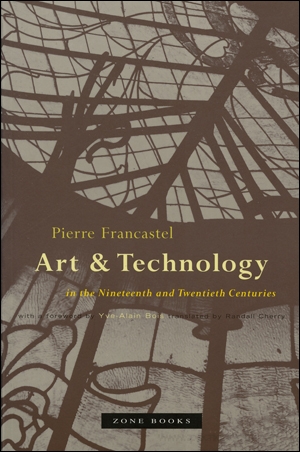Pierre Francastel: Art & Technology in the Nineteenth and Twentieth Centuries (1956–) [ES, EN]
Filed under book | Tags: · art history, design, design history, history of architecture, machine, technology

“Although the work of Pierre Francastel (1900-1970) has long carried the label “sociology of art,” it bears little resemblance to anything conventionally sociological. Unlike the followers of the dominant schools of Anglo-American and German art history, Francastel was never obsessed with establishing a quasi-scientific methodology as the basis for his studies. But as art history itself is being reconfigured amid the technological culture of the twenty-first century, his nuanced meditations from the 1950s on the intricate intersection of technology and art gain heightened value.
The concrete objects Francastel examines are for the most part from the architecture and design of the late nineteenth to mid-twentieth century. Through them, he engages his central problem: the abrupt historical collision between traditional symbol activities of human society and the appearance in the nineteenth century of unprecedented technological and industrial capabilities and forms.”
First published as Art et technique aux XIXe et XXe siècles, Paris, 1956.
English edition
With a Foreword by Yve-Alain Bois
Translated by Randall Cherry
Publisher Zone Books, New York, 2000
ISBN 1890951021, 9781890951023
331 pages
Review: Sean Cubitt (Leonardo, 2001).
Arte y técnica en los siglos XIX y XX (Spanish, trans. Maria Jose Garcia Ripoll, 1990, 22 MB, via)
Art & Technology in the Nineteenth and Twentieth Centuries (English, trans. Randall Cherry, 2000, 14 MB, updated on 2019-10-11)
Glass Bead, 2: Site 1: Logic Gate, the Politics of the Artifactual Mind (2017) [English/French]
Filed under journal | Tags: · abstraction, artificial intelligence, inhuman, logic, machine, mind, theory

“The first issue of the journal was dedicated to repositioning art in the landscape of reason. This issue is focused on the fabric of reason itself, and the ways in which it is currently altered by the emergence of artificial intelligence.
While the capacities of thought are being externalized in machines that increasingly mirror human intelligence, the question of the technical artifactuality of mind and its political ramifications becomes particularly pressing.
For us, far from being limited to the computational instantiation of intelligence, understanding the politics of these developments in artificial intelligence requires acknowledging that mind has always been artifactual.
Site 1: Logic Gate, the Politics of the Artifactual Mind proposes to explore the formal, philosophical and scientific dimensions of this question, so as to consider the role art might play in the lucid unfolding of its possibilities.”
With contributions by Danielle Macbeth, Gary Tomlinson, Matt Hare, Ben Woodard, Nina Power, Matteo Pasquinelli, Benjamin Bratton, Nora Khan, Hito Steyerl, Ian Cheng, Catarina Dutilh Novaes, Reviel Netz, Peli Grietzer, Lee Gamble, Dhanveer Singh Brar, T’ai Smith, and James Trafford.
Edited by Fabien Giraud, Jeremy Lecomte, Vincent Normand, Ida Soulard, and Inigo Wilkins
Publisher Glass Bead, November 2017
HTML, PDFs (English)
HTML, PDFs (French)
See also Issue 1
Media Theory 1(1): Manifestos (2017)
Filed under journal | Tags: · computing, machine, manifesto, media, media theory, theory

For this launch issue of the journal, editorial and advisory board members were invited to set out their own views on the importance of (a new journal of) media theory.
With contributions by W.J.T. Mitchell , Liam Cole Young, Scott McQuire, Terry Flew, Marc Steinberg, Raka Shome, David M. Berry, Ned Rossiter, Johan Soderberg, M. Beatrice Fazi, John W.P. Phillips, Mickey Vallee, Rob Shields, Jane Birkin, Sunil Manghani, Gary Hall, Christoph Raetzsch, and Sean Cubitt.
Edited by Simon Dawes
Published 22 October 2017
Creative Commons BY-NC-ND License

